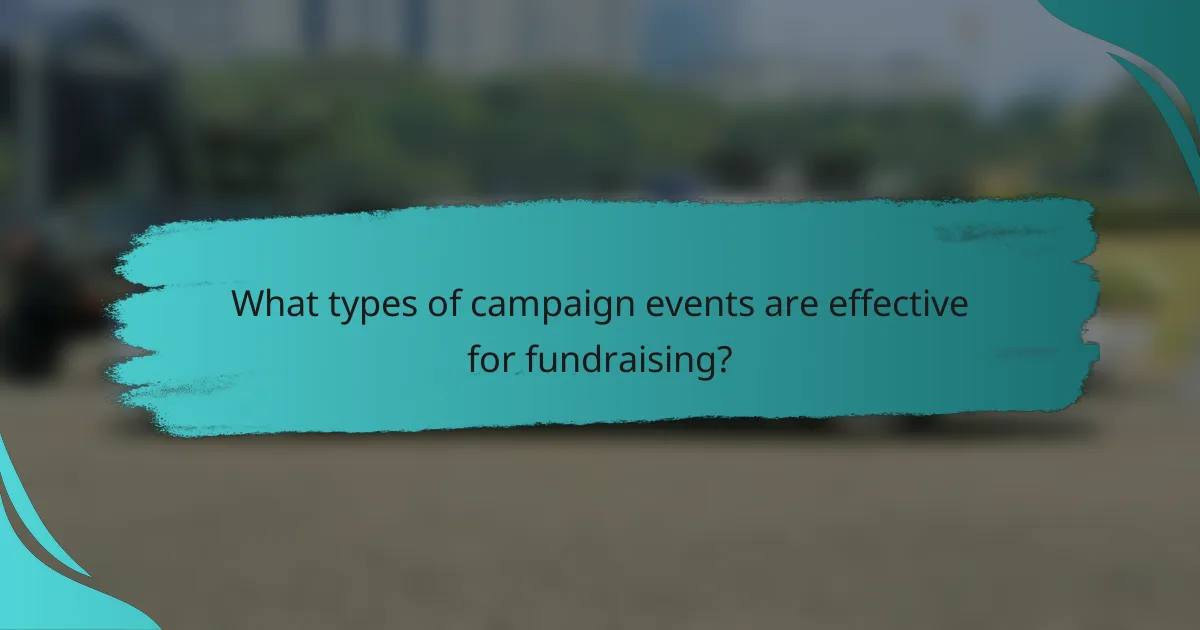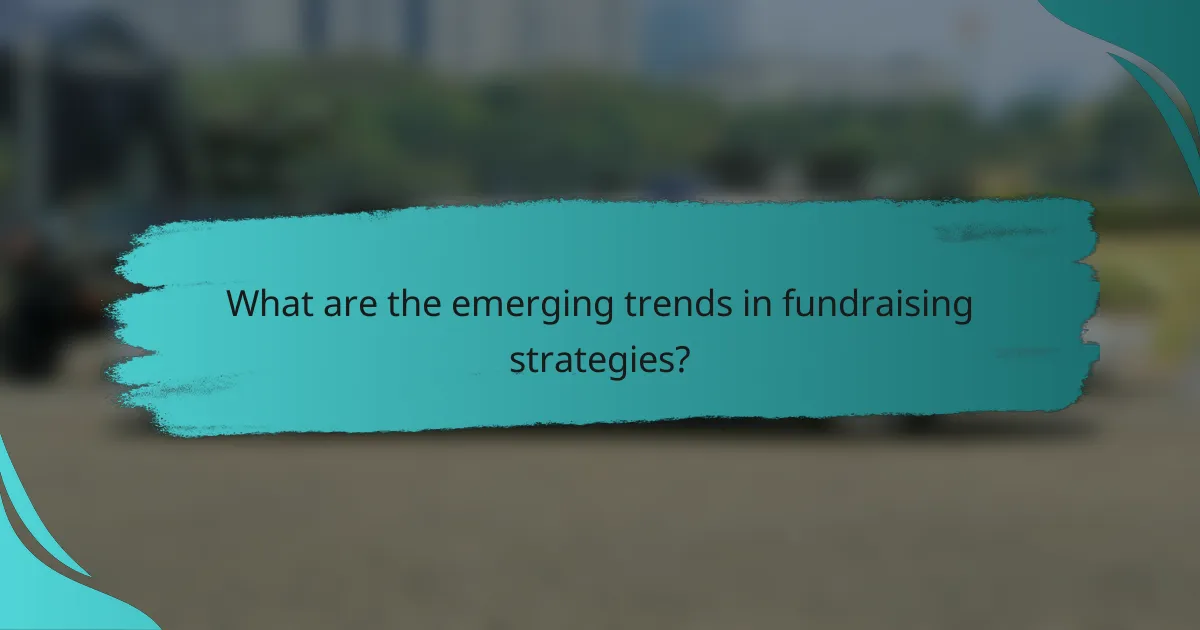Developing a successful fundraising strategy begins with identifying potential donors who resonate with your mission and values, utilizing various research methods and community connections. Engaging campaign events can create memorable experiences that not only raise funds but also strengthen donor relationships. Additionally, implementing systematic financial tracking methods is crucial for monitoring income and expenses, ensuring that your organization meets its financial goals effectively.

How to identify potential donors in the UK?
Identifying potential donors in the UK involves researching individuals and organizations that align with your mission and values. Effective strategies include utilizing databases, engaging with social networks, and connecting with local community groups to expand your reach.
Utilize donor databases like DonorSearch
Donor databases such as DonorSearch provide valuable insights into potential donors’ giving history and philanthropic interests. By analyzing this data, you can identify individuals or organizations that have previously supported causes similar to yours.
Consider subscribing to these databases, as they often offer detailed profiles that can help you tailor your outreach efforts. Look for key indicators like donation amounts and frequency to prioritize your engagement with the most promising prospects.
Leverage social media platforms for outreach
Social media platforms like Facebook, Twitter, and LinkedIn are powerful tools for identifying and engaging potential donors. By sharing your mission and success stories, you can attract individuals who resonate with your cause and may be inclined to contribute.
Utilize targeted advertising to reach specific demographics or interests that align with your fundraising goals. Regularly interact with followers to build relationships and foster a sense of community around your organization.
Engage with local community organizations
Partnering with local community organizations can significantly enhance your donor identification efforts. These groups often have established networks and can introduce you to potential supporters who are already invested in community development.
Attend local events, workshops, or meetings to connect with these organizations and their members. Building relationships within the community can lead to collaborative fundraising opportunities and increase your visibility among potential donors.

What types of campaign events are effective for fundraising?
Effective fundraising campaign events engage donors and create memorable experiences while raising money. Popular options include charity auctions, fun runs, and virtual webinars, each offering unique benefits and considerations.
Host charity auctions in London
Charity auctions in London can attract high-profile donors and generate significant funds. These events often feature unique items or experiences, such as art pieces, exclusive dinners, or travel packages, appealing to affluent attendees.
To maximize success, consider partnering with local businesses for donations and sponsorships. Promote the event through social media and local press to reach a wider audience. Ensure a seamless bidding process, whether live or silent, to encourage competitive bids.
Organize fun runs in regional parks
Fun runs in regional parks are an engaging way to involve the community while raising funds. Participants typically pay an entry fee, and additional funds can be raised through sponsorships and merchandise sales.
Choose a scenic location and set a reasonable distance, such as 5K or 10K, to attract a diverse group of participants. Promote the event through local schools, fitness clubs, and social media. Offering incentives, like medals or T-shirts, can enhance participation and create a sense of achievement.
Conduct virtual fundraising webinars
Virtual fundraising webinars allow organizations to reach a global audience without geographical limitations. These online events can include guest speakers, educational content, and live donation appeals, making them versatile and cost-effective.
To ensure engagement, keep webinars interactive with Q&A sessions and polls. Promote the event through email campaigns and social media, and consider offering exclusive content or resources for attendees. Utilize a reliable platform to facilitate smooth streaming and donation processing.

How to track financial performance in fundraising?
To effectively track financial performance in fundraising, organizations should implement systematic methods for monitoring income, expenses, and donor engagement. This includes using software tools, spreadsheets, and analyzing donor behavior to ensure financial goals are met.
Implement software like Salesforce for Nonprofits
Using specialized software such as Salesforce for Nonprofits can streamline financial tracking by providing a centralized platform for managing donor information and campaign data. This software allows organizations to track donations, manage relationships, and generate reports that reflect financial performance.
Consider integrating features like automated reminders for follow-ups and customizable dashboards to visualize fundraising progress. Additionally, Salesforce can help identify trends in donor behavior, which can inform future fundraising strategies.
Use Excel for budget tracking
Excel is a versatile tool for budget tracking, allowing organizations to create detailed financial spreadsheets that monitor income and expenses. By setting up a budget template, you can easily input data and calculate variances to see how actual performance aligns with your financial goals.
Utilize formulas to automate calculations and consider using charts for visual representation of your budget. Regularly updating your Excel sheets can help identify spending patterns and areas where adjustments may be necessary.
Analyze donor retention rates
Analyzing donor retention rates is crucial for understanding the effectiveness of your fundraising efforts. By tracking how many donors continue to contribute year over year, organizations can gauge the success of their engagement strategies and identify areas for improvement.
To calculate retention rates, divide the number of returning donors by the total number of donors from the previous year. Aim for a retention rate of at least 40-60%, as this indicates a healthy donor base. Regularly reviewing these rates can help refine your approach to donor engagement and increase long-term support.

What are the prerequisites for a successful fundraising strategy?
A successful fundraising strategy requires a clear understanding of your goals, a solid marketing plan, and effective financial tracking. These elements work together to identify potential donors, engage them through compelling campaigns, and monitor financial performance to ensure sustainability.
Establish clear fundraising goals
Setting clear fundraising goals is essential for guiding your strategy and measuring success. Goals should be specific, measurable, achievable, relevant, and time-bound (SMART). For example, aiming to raise $50,000 within six months for a community project provides a clear target.
Consider breaking down larger goals into smaller milestones. This approach allows for tracking progress and making adjustments as needed. For instance, if your goal is $50,000, you might set quarterly targets of $12,500 to keep the momentum going.
Build a strong marketing plan
A strong marketing plan is crucial for reaching potential donors and effectively communicating your mission. Start by identifying your target audience and tailoring your messaging to resonate with them. Utilize various channels such as social media, email campaigns, and community events to maximize outreach.
Incorporate storytelling into your marketing efforts to create an emotional connection with donors. Share success stories and testimonials that highlight the impact of contributions. Additionally, consider using visuals like infographics or videos to make your campaigns more engaging.

How to choose the right fundraising platform?
Selecting the right fundraising platform involves assessing your specific needs, such as ease of use, audience reach, and integration capabilities. Prioritize platforms that align with your campaign goals and provide the tools necessary for effective donor engagement and financial tracking.
Compare features of platforms like GoFundMe and JustGiving
GoFundMe is known for its user-friendly interface and broad audience reach, making it ideal for personal fundraising and community-based campaigns. JustGiving, on the other hand, offers robust features for charities, including donation tracking and integration with social media, which can enhance visibility and engagement.
When comparing these platforms, consider the types of campaigns you plan to run. GoFundMe is often preferred for individual projects, while JustGiving is tailored for nonprofit organizations seeking to raise funds for specific causes.
Evaluate transaction fees and payout times
Transaction fees can significantly impact the total funds raised. GoFundMe typically charges a percentage of the donations, which can vary by country, while JustGiving may have a fixed fee structure along with a percentage. It’s essential to review the fee schedules on each platform to understand the net amount you will receive.
Payout times also differ between platforms. GoFundMe generally processes payouts within a few business days, while JustGiving may take longer, especially for first-time users. Always check the specific terms and conditions to avoid surprises during your fundraising campaign.

What are the emerging trends in fundraising strategies?
Emerging trends in fundraising strategies focus on leveraging technology, enhancing donor engagement, and promoting sustainability. Organizations are increasingly adopting innovative methods to identify donors, streamline campaigns, and track financial contributions effectively.
Incorporate AI for donor analysis
Using AI for donor analysis allows organizations to identify potential contributors more efficiently. AI tools can analyze past donation patterns, demographic data, and engagement levels to predict future giving behavior.
Consider implementing machine learning algorithms that segment donors based on their likelihood to give, which can help tailor outreach efforts. For example, targeting high-potential donors with personalized messages can significantly improve response rates.
Utilize mobile giving solutions
Mobile giving solutions are becoming essential as more donors prefer to contribute via their smartphones. These platforms enable quick and easy donations, often through text messages or dedicated apps.
To maximize effectiveness, ensure that your mobile giving options are user-friendly and secure. Offering various payment methods, such as credit cards and digital wallets, can also enhance donor convenience and increase overall contributions.
Focus on sustainability in fundraising events
Incorporating sustainability into fundraising events is increasingly important for attracting environmentally conscious donors. This can involve using eco-friendly materials, minimizing waste, and choosing sustainable venues.
When planning events, consider strategies like digital ticketing and virtual participation options to reduce carbon footprints. Highlighting these efforts in your marketing can resonate with potential donors who prioritize sustainability in their giving decisions.